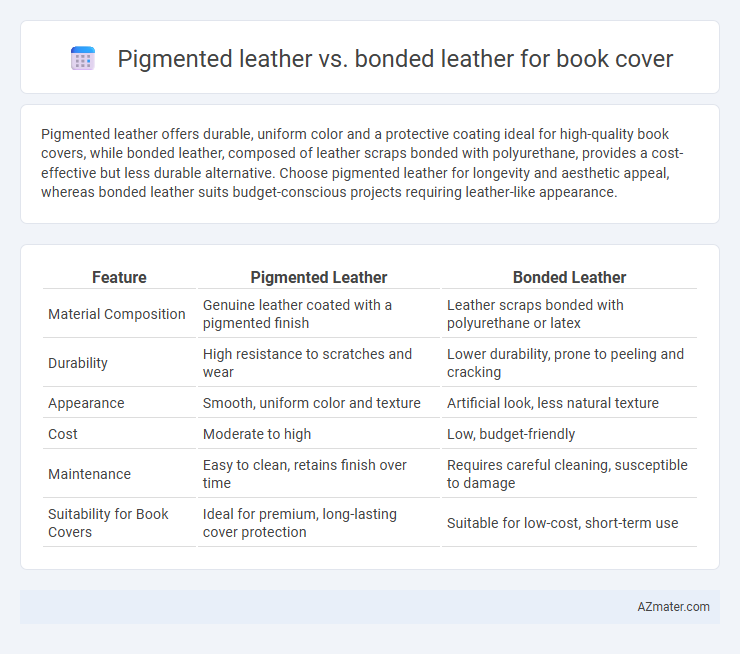Pigmented leather offers durable, uniform color and a protective coating ideal for high-quality book covers, while bonded leather, composed of leather scraps bonded with polyurethane, provides a cost-effective but less durable alternative. Choose pigmented leather for longevity and aesthetic appeal, whereas bonded leather suits budget-conscious projects requiring leather-like appearance.
Table of Comparison
| Feature | Pigmented Leather | Bonded Leather |
|---|---|---|
| Material Composition | Genuine leather coated with a pigmented finish | Leather scraps bonded with polyurethane or latex |
| Durability | High resistance to scratches and wear | Lower durability, prone to peeling and cracking |
| Appearance | Smooth, uniform color and texture | Artificial look, less natural texture |
| Cost | Moderate to high | Low, budget-friendly |
| Maintenance | Easy to clean, retains finish over time | Requires careful cleaning, susceptible to damage |
| Suitability for Book Covers | Ideal for premium, long-lasting cover protection | Suitable for low-cost, short-term use |
Introduction to Pigmented and Bonded Leather
Pigmented leather features a protective coating infused with color pigments, enhancing durability and resistance to stains and fading, making it ideal for book covers requiring long-lasting quality. Bonded leather consists of leather scraps and fibers bonded together with polyurethane or latex, offering a cost-effective alternative but with less durability and a shorter lifespan. Choosing between pigmented and bonded leather impacts the book cover's texture, appearance, and endurance.
What is Pigmented Leather?
Pigmented leather is a type of leather treated with a polymer coating that contains pigments, creating a uniform color and enhanced durability for book covers. This coating forms a protective layer that resists scratches, stains, and fading, making pigmented leather ideal for high-use items like book bindings. Compared to bonded leather, pigmented leather retains the natural grain and strength of full or top-grain leather, providing superior longevity and a consistent, polished appearance.
What is Bonded Leather?
Bonded leather is made by combining shredded leather fibers with a polyurethane or latex binder, resulting in a material that mimics the look of genuine leather at a lower cost. It offers a smooth surface and can be printed or embossed easily, but it lacks the durability and natural texture of pigmented leather, which is coated with a pigment layer to enhance resistance and uniformity. For book covers, bonded leather provides an affordable aesthetic option but may wear and peel faster compared to the more robust pigmented leather.
Key Differences Between Pigmented and Bonded Leather
Pigmented leather features a durable protective coating that enhances color uniformity and resists stains, making it ideal for book covers requiring long-lasting appearance and protection. Bonded leather consists of leather fibers mixed with synthetic materials, offering a lower-cost alternative but less durability and a tendency to wear or peel over time. Key differences include pigmented leather's superior abrasion resistance and texture retention compared to bonded leather's limited lifespan and variability in quality.
Durability: Pigmented Leather vs Bonded Leather
Pigmented leather offers superior durability for book covers due to its thick protective coating, which resists scratches, stains, and fading over time, making it ideal for frequent handling. Bonded leather, composed of leather scraps bonded with polyurethane, tends to wear out faster, peeling and cracking with regular use, resulting in a shorter lifespan. Choosing pigmented leather ensures long-lasting protection and maintains the book's aesthetic appeal much better than bonded leather.
Appearance and Texture Comparison
Pigmented leather offers a uniform, smooth surface with a consistent color finish due to its polyurethane coating, making it highly durable and resistant to stains and fading. Bonded leather, composed of leather fibers mixed with polyurethane or latex on a fabric backing, typically exhibits a less natural texture with a flatter, more artificial appearance prone to cracking and peeling over time. The tactile feel of pigmented leather is firmer and more refined, whereas bonded leather tends to feel softer but less authentic, often lacking the rich grain and depth of genuine leather finishes ideal for premium book covers.
Cost Considerations for Book Covers
Pigmented leather offers a higher durability and premium feel for book covers, but typically comes at a significantly higher cost compared to bonded leather, which is made from leather scraps and synthetic materials. Bonded leather is more budget-friendly, making it an attractive choice for mass production or lower-cost editions, yet it compromises on longevity and texture quality. Evaluating the cost-to-durability ratio is crucial for publishers aiming to balance investment with the desired aesthetic and lifespan of book covers.
Environmental Impact and Sustainability
Pigmented leather, coated with a durable polymer layer, tends to have a larger environmental footprint due to chemical treatments and finishes involved in its production. Bonded leather, made from leather scraps mixed with synthetic materials, often contains adhesives and plastics that challenge biodegradability and recycling efforts, raising sustainability concerns. Choosing natural, uncoated leathers or alternative eco-friendly materials can reduce environmental impact in book cover manufacturing.
Best Applications: When to Use Each Type
Pigmented leather offers superior durability and resistance to stains, making it ideal for high-use book covers such as textbooks and reference volumes that require long-lasting protection. Bonded leather, composed of leather scraps mixed with synthetic materials, is best suited for decorative or short-term applications like limited edition prints and light-use journals due to its affordability and varied texture options. Choosing between pigmented and bonded leather depends on balancing cost, durability, and appearance requirements tailored to the intended use of the book cover.
Final Verdict: Choosing the Right Leather for Your Book Cover
Pigmented leather offers superior durability, resistance to stains, and a consistent finish, making it ideal for high-usage book covers that require long-lasting protection and a polished look. Bonded leather, while more affordable and environmentally friendly, lacks the robustness and uniformity, often resulting in quicker wear and less premium appearance. For a book cover prioritizing longevity and aesthetic quality, pigmented leather remains the preferred choice despite its higher cost.

Infographic: Pigmented leather vs Bonded leather for Book cover
 azmater.com
azmater.com